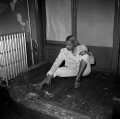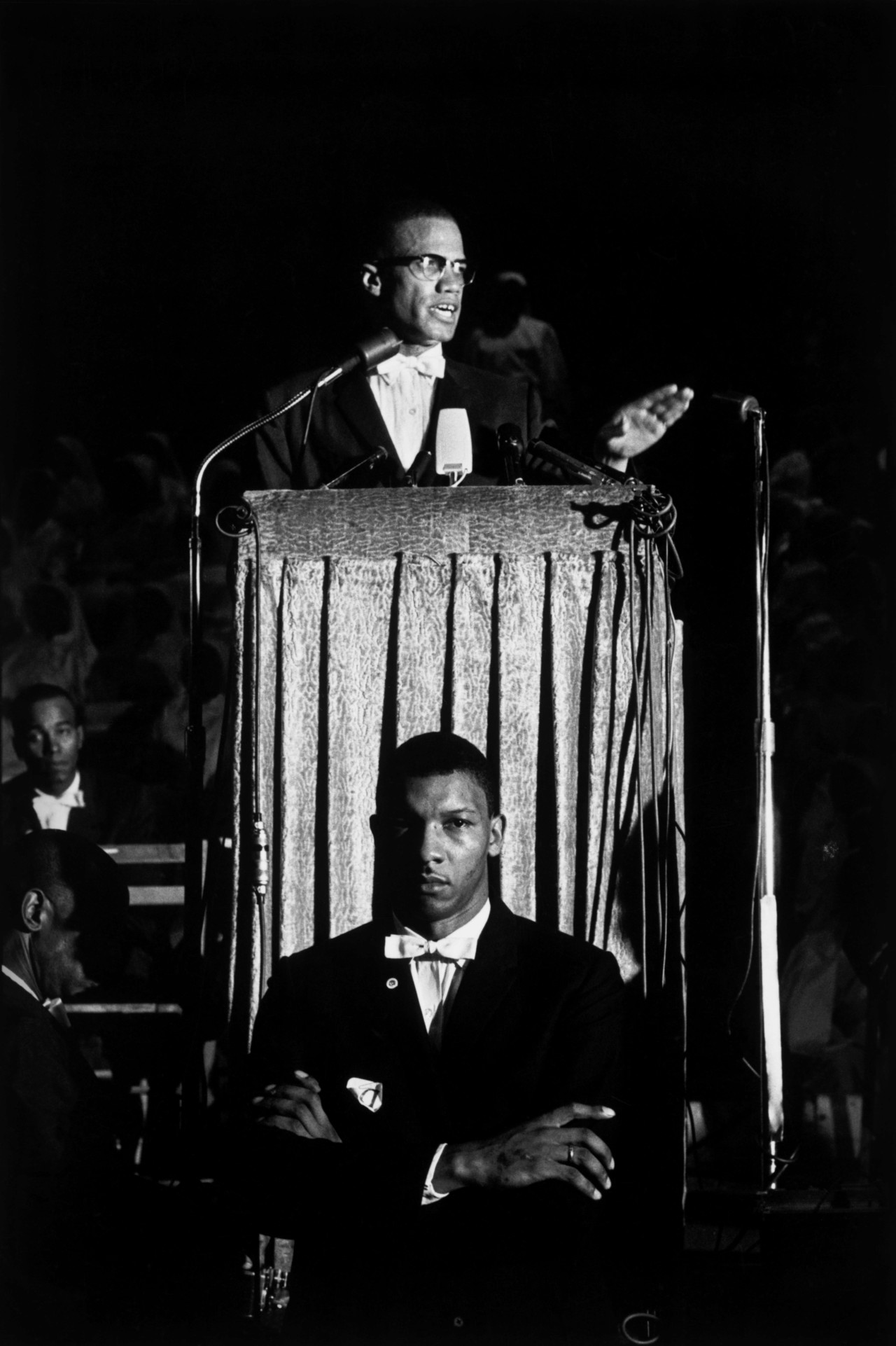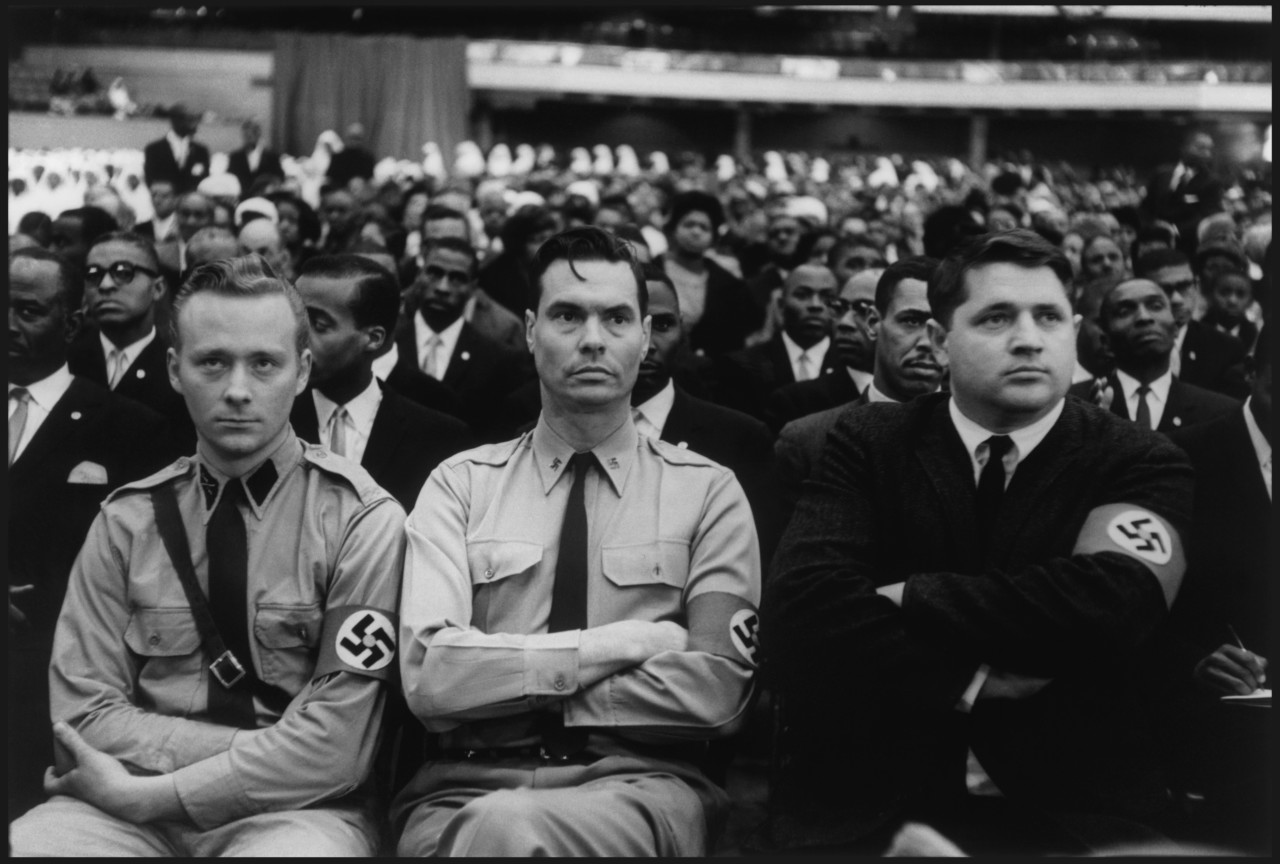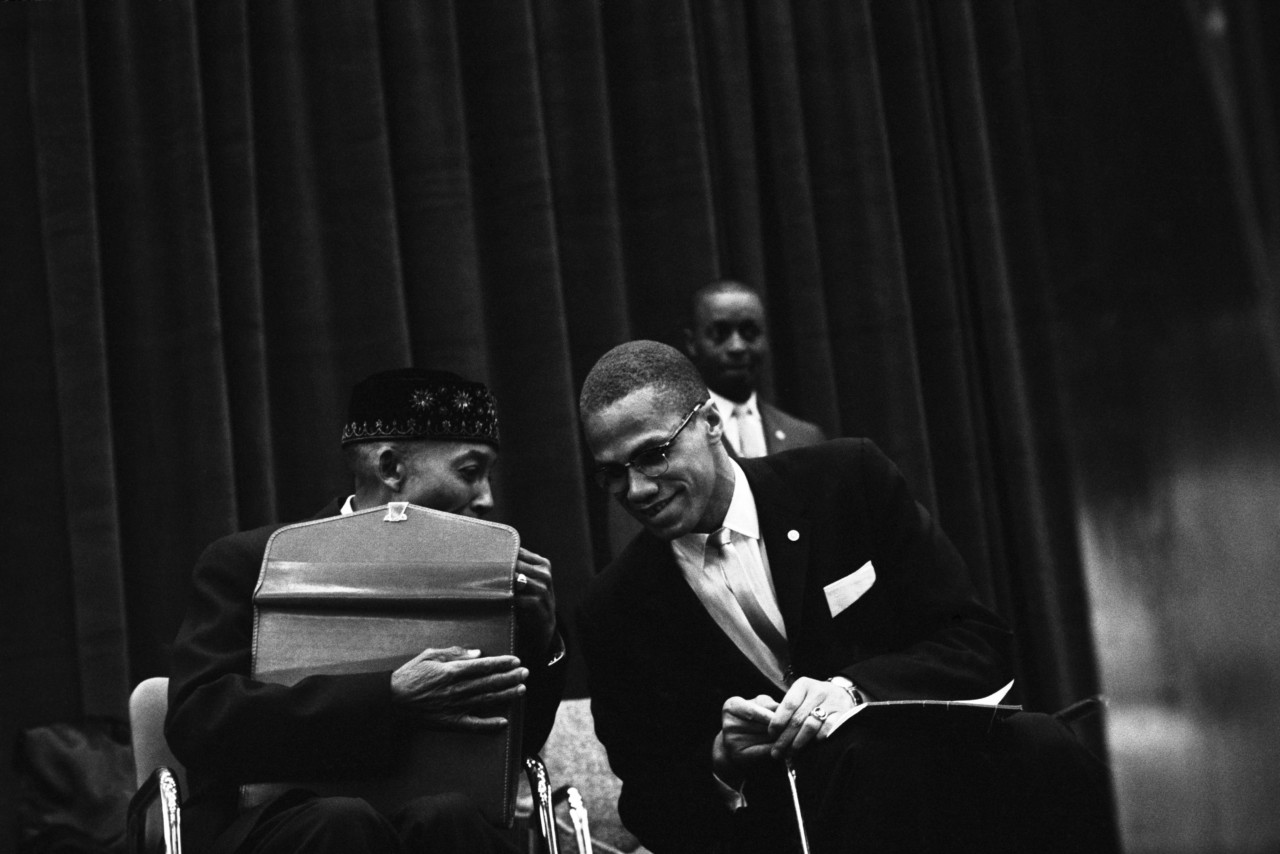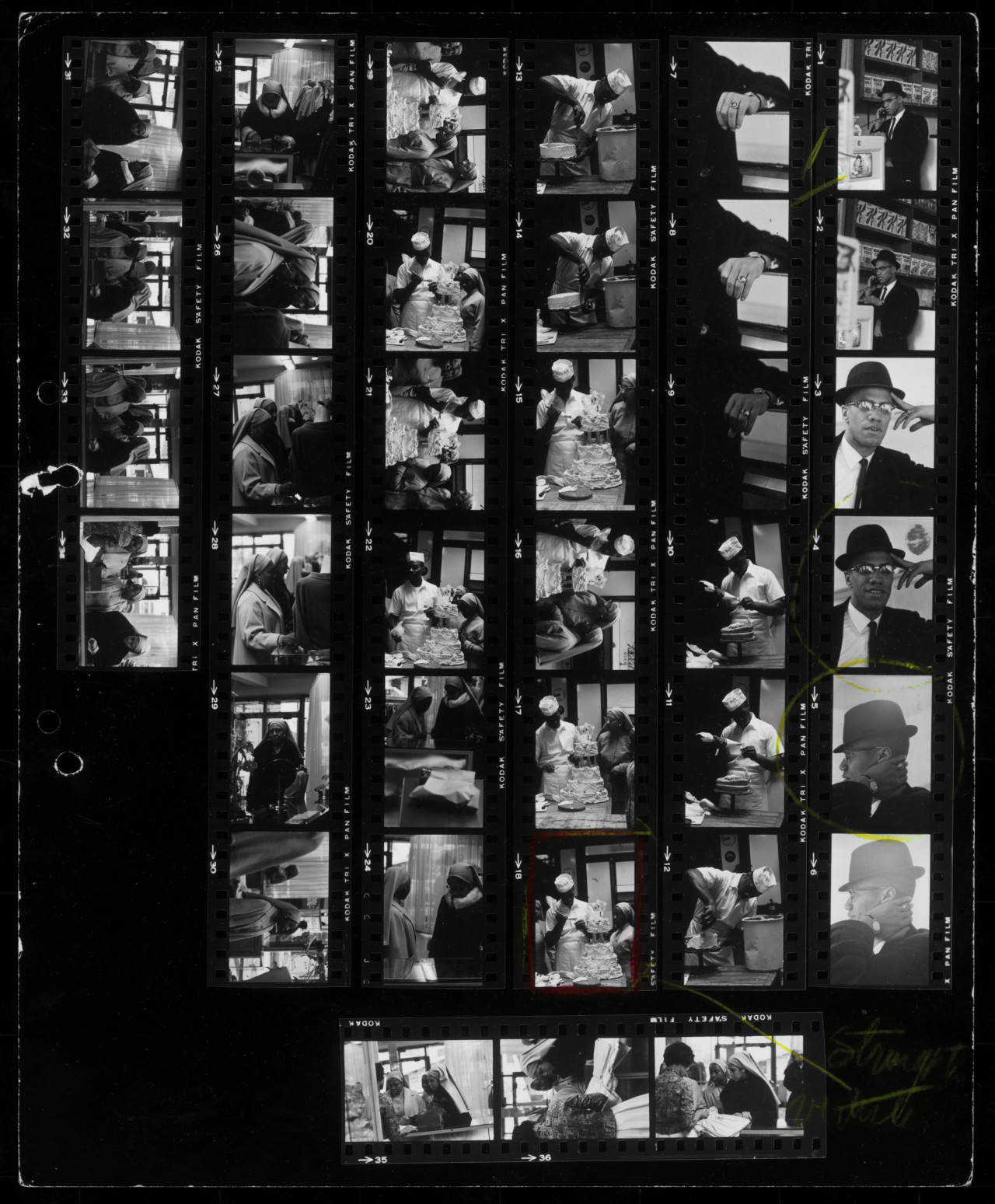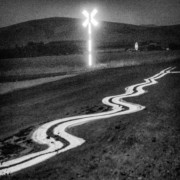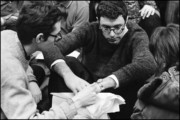Eve Arnold’s Time With Malcolm X and the Nation of Islam, in Her Own Words
In 1961 the photographer was assigned to document the man she came to see as "one of the most dynamic leaders of the century"
The hardline political and religious movement, the Nation of Islam, was founded in Detroit, Michigan, by Wallace D. Fard Muhammad in July 1930. Fard claimed that he was sent to wake “the black nation to the full range of the black man’s possibilities in a world temporarily dominated by blue-eyed-devils.” Fard disappeared four years after starting the group, at which his assistant Elijah Muhammad took over, and moved the group’s base from Michigan to Chicago. At one point the Nation’s promotion of the concept of the geographical racial segregation of America led it into a surprising if shortlived allegiance with the American Nazi Party – a surreal meeting that Eve Arnold captured in 1961 as part of an assignment from Life magazine.
On this assignment Arnold followed the black nationalist movement’s members and leaders to meetings and rallies and – in particular – profiled a senior figure in the group who was to become its most recognisable figurehead of the period: Malcolm X.
While part of the Nation of Islam, Malcolm X preached the group’s line on the superiority of the black race, but in 1964 he parted with the movement to pursue a more traditional form of Islam – adopting the name El-Hajj Malik El-Shabazz – after which he continued working to champion the cause of African Americans and to raise awareness of the iniquities they lived under.
His famous endorsement of the ‘by any means necessary’ stance – calling for the the use of arms and violence in defence of self, family and property – set him at odds with prominent pacifist African American leaders like Dr Martin Luther King, while making him a hero figure to many who were tired of systemic racism, and widespread police and government brutality. In spite of his extremist rhetoric while a part of the Nation of Islam, El-Shabazz later distanced himself from the more extreme ideological aspects of his former peers’ beliefs. While remaining controversial in some circles he became one of the key figures in the civil rights movement, before being assassinated in 1965, at the Audubon Ballroom in the Washington Heights area of New York City.
Here, to mark the anniversary of Malcolm X’s birthdate (and the recent observation by some of the semi-official US holiday – Malcolm X Day) we reproduce Arnold’s own writings about her time with the leader and the movement from her book, Eve Arnold, In Retrospect. Arnold dwells upon the difficulties of the assignment, the lessons it taught her about editorial work, Malcolm X’s canny use of the media for his own ends, and the making of her now famed portrait of the controversial firebrand she came to respect and be friendly with.
Photographing movie stars was child’s play compared to the problems to be hurdled when Life magazine assigned a political story on Malcolm X, the emerging leader of the Black Muslims.
Before asking the magazine to commit itself, there was a major research job to be done. The Muslims were a virtually impregnable wall to broach. Through sources I no longer remember I contacted a man called Louis Lomax who was a journalist with access to Malcolm X. We agreed to lunch to discuss the possibility of my hiring him to set things up for me.
We were to meet at Del Pezzo’s, an Italian restaurant, now defunct, on 47th Street. When I had waited for him for two hours and the restaurant was about to close for the afternoon, he breezed in. I tried to contain my displeasure and ordered him a drink, and before I could say anything about the Black Muslims he said, “You don’t want to do a story, you just want to sleep with a black man, don’t you?”
I was enraged, let rip a few nasty sentences, and started to walk out. He caught up with me, apologized, said he was just testing, and led me back to our drinks. We agreed that for a sum he would be the fixer for the story. We then went down the street to the Magnum office to get him a check to seal the bargain. Lomax was invaluable during the years I worked on the story. He meticulously carried out everything he had promised, beginning with the introduction to Malcolm X. What he had not told me was that I was just one of his many clients. At every public meeting he raced about servicing both major television networks as well as several newspapers. He was a busy man indeed, leaving me to wonder how he found time for the sexual exploits he bragged about.
"The arena was packed - estimates ran between five and six thousand. Who were these immaculate people? What were their teachings? their beliefs?"
- Eve Arnold
The first contact with Malcolm X was at the Uline Arena in Washington, at a national convention of all chapters of the Black Muslims. People had come by the busload from all over America. The males (even boys) were in black suits, white shirts and black ties, their boots highly polished. The females (even the youngest) wore white dresses, and their heads were modestly covered in white scarves. There was an honor guard for the Prophet, Elijah Muhammad, the messenger of Allah, as well as an elite young military guard called the Fruit of Islam who carried no guns but had been taught to kill with their hands.
We were frisked for weapons – I by the women. The meeting hall was festooned with banners that bore the legends “We Must Protect Our Women” and “There Is No God But Allah.” The arena was packed – estimates ran between five and six thousand. Who were these immaculate people? What were their teachings? their beliefs? They were taught that the black race is the superior race, that all black men are brothers, that allegiance must be to the flag of Islam, that the white man is the devil and must be overthrown, that unless America changed its wicked ways it would burn for 360 years. They were enjoined to bathe daily and were forbidden to smoke, drink alcohol, take narcotics or eat pork. They demanded separation or death, calling upon the U.S. government to give them the states of the Eastern Seaboard so that they could establish their own autonomy.
The seating plan segregated the men and women – the women upstairs, the men downstairs. In the front row facing the podium sat George Lincoln Rockwell, the head of the American Nazi Party, with his henchmen. They were in military khakis and sported swastika armbands. The reason for this unholy alliance was that the Nazis and the Muslims had a common goal – to divide America between them. The Muslims would get the entire Eastern Seaboard, the Nazis the rest.
When I raised the camera to photograph Rockwell and his men, he hissed at me, “I’ll make a bar of soap out of you.” I hissed back. “As long as it isn’t a lampshade,” and kept on photographing.
"The reason for this unholy alliance was that the Nazis and the Muslims had a common goal -to divide America between them. The Muslims would get the entire Eastern Seaboard, the Nazis the rest. When I raised the camera to photograph Rockwell and his men, he hissed at me, "I'll make a bar of soap out of you.""
- Eve Arnold
Over the next year (1960) I followed Malcolm from Washington to New York and Chicago and then back to New York. He was cooperative and considerate. As we worked together, the passionate orator who could whip a crowd to euphoria, who could convince a University of Chicago student audience with sheer sophistry that the white man was the villain who had introduced the slave trade in Africa and that the Arab was blameless, began to unbend and to think of situations for me to photograph.
First he asked me to dinner at a restaurant in Harlem owned by the Black Muslims. The place was spotless (the Muslims were always saying the whites didn’t bathe and smelled bad). Malcolm was charming, made small talk to put me at ease, and said some gracious words about my work. The food was delicious. I was served a dish that in my ignorance I referred to as a “sweet potato pie.” The waiter froze. When I asked what I had done, Malcolm told me that their religion forbade them to eat the food they had eaten in slavery.
“Then what,” I asked, “is in the pie?”
“It’s made with beans – white beans.”
The “white” was underscored with such venom that I wondered if it was meant to make me feel like a cannibal. But his eyes glinted behind his spectacles, and he laughed. From that time on he would tease me and make jokes.
That night Malcolm took me to a rally on 125th Street. As I walked about the crowd taking photographs, there were cries of “White bitch!” and “Kill the white bitch!” and I was spat upon. It was a mild spring night and I wore a light wool dress and a light wool sweater. Luckily for me my clothes were wool: wool doesn’t burn, it smolders. Later when I took off my sweater to remove the film from its zippered pockets, I saw that the entire back was polka-dotted with cigarette burns. As I had moved about the crowd, they had stuck burning cigarettes into the sweater. I must have been moving too fast for them to get to the flesh.
When I went to Chicago it was to see the way the Muslims dealt with whitey through their economic boycott. They set up clothing factories, bakeries, grocery shops, restaurants and other small businesses that were owned and operated by their members to service their own people. The Chicago community was thriving, so Malcolm thought it should be photographed as part of my article.
For the two weeks I worked in Chicago, at eight o’clock each morning I received a telephone call, Someone with a Southern accent said, “Get the hell out of town before it’s too late,” and hung up. Half an hour later Malcolm would call, polite but brisk, and give me an address in the black ghetto where I was to meet him. He called each morning with instructions, but so did the person with the same message to get the hell out of town before it was too late. I don’t know why I wasn’t frightened, but I wasn’t, and although it did occur to me to tell the Life bureau in Chicago, I didn’t-because I was afraid Life would take me off the story.
"As we worked together, the passionate orator who could whip a crowd to euphoria... began to unbend and to think of situations for me to photograph."
- Eve Arnold
I felt that Malcolm wouldn’t let anything happen to me. He continued to be friendly, and surprised me by bringing ten Muslim women in their white habits to be photographed, He was a clever showman and apparently knowledgeable about how he could use pictures and he press to tell his story. He set up the shots while I clicked the camera. It was hilarious. I tried several times to get him in the act of framing a photo with his hands, but he was too quick for me. With the photos of himself, he was professional and imaginative. He obviously had an idea of how he wanted the public to see him and he maneuvered me into showing him that way. I am always delighted by the manipulation that goes on between subject and photographer when the subject knows about the camera and how it can best be used to his advantage. Malcolm was brilliant at this silent collaboration. He knew his needs, his wants, his best points and how to get me to give him what he required.
"I am always delighted by the manipulation that goes on between subject and photographer when the subject knows about the camera and how it can best be used to his advantage. Malcolm was brilliant at this silent collaboration. He knew his needs, his wants, his best points and how to get me to give him what he required."
- Eve Arnold
I was amused recently at an International Center of Photography group show of pictures of Malcolm. The lead picture was one of mine: a huge smiling profile of him looking smart; hat, gold watch and Masonic ring worn jauntily. A group of young black photographers came over to talk to me. “Thank you,” they said, “for making him look like a dude.”
“It was a collaboration,” I said.
In addition to making sure that I got the pictures necessary for a large photo-essay, Malcolm arranged interviews for my text. I talked to one indoctrinated Muslim who was a cook in a Detroit hotel before he became a captain in the elite guard, the Fruit of Islam, the group taught to kill with their hands. He said, “I want my gold shoes now. I want my white robes now. I want my milk and honey right now. I have sung too many songs in the Baptist Church and had too much water poured over me. I want now what the white man has.”
Sitting opposite this man and looking at those fanatic eyes and seeing the purpose that this movement had given him, I understood. He looked like any other cook, but cleaner: neatly pressed grey flannel suit, neat black tie, polished shoes. But there was a difference: he had a dignity he had never had before. True, he had been given a ready-made heritage and a restricted channel for his life, what Allah wills he does not question, but he had identification with the worldwide stirring of black and colored people, and with the gathering strength of Islam. This is Malcolm’s legacy.
My son once asked me how I reacted to those vears of intimidation. Had I been frightened? angry? vexed? The question surprised me. I had been none of these during the entire period – from research to finish. All of it seemed expected to me. I had undertaken a difficult and possibly dangerous story and it was my job to get it done. Then I remembered that when it was all over I got a severe case of the shakes.
The final misery was my battle with the Life editor who refused to run the story on the grounds that nobody knew who the Black Muslims were, so why devote space to them? He finally and grudgingly consented to lay the story out for publication.
Here I was unlucky: the closing picture of the wife and daughter of Elijah Muhammad at prayer running half page depth across two pages was unfortunately placed above an advertisement for Oreo cookies that read, “The Greatest Chocolate Cookie of Them All.” The editors removed my embarrassing editorial material. The ad stayed. The Black Muslim project had taught me a great deal about research, about photographing under stress, about dealing with everything from the technical to the human elements involved, and as a bonus I had been privileged to work with one of the most dynamic leaders of the century.




